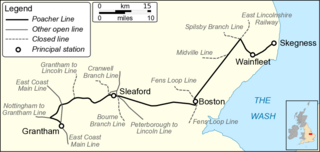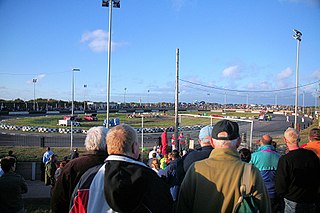
Skegness is a seaside town and civil parish in Lincolnshire, England. On the Lincolnshire coast of the North Sea, the town is 43 miles (69 km) east of Lincoln and 22 miles (35 km) north-east of Boston. With a population of 19,579, it is the largest settlement in the East Lindsey district. It also incorporates Winthorpe and Seacroft, and forms a larger built-up area with the resorts of Ingoldmells and Chapel St Leonards to the north. The town is on the A52 and A158 roads, connecting it with Boston and the East Midlands, and Lincoln respectively. Skegness railway station is on the Nottingham to Skegness line.

East Lindsey is a local government district in Lincolnshire, England. The population of the district council was 136,401 at the 2011 census. The council is based in Manby. Other major settlements in the district include Alford, Spilsby, Mablethorpe, Skegness, Horncastle, Chapel St Leonards and Louth. Skegness is the largest town in East Lindsey, followed by Louth and Mablethorpe.

The Bluestone Heath Road is an ancient route and ridgeway across the Lincolnshire Wolds in Lincolnshire, England. The surviving parts are somewhat fragmented in places, but many still bear the name.

The Grantham–Skegness line, originally promoted as the "Poacher Line", runs for 55 miles (89 km) between Grantham and Skegness in Lincolnshire, England. Trains on this route originate from Nottingham via the Nottingham to Grantham Line as an hourly through service from Nottingham to Skegness, with slower stopping services at peak times. The line is operated by East Midlands Railway British Rail Class 156 "Super-Sprinter", British Rail Class 153 "Super-Sprinter" and British Rail Class 158 "Sprinter Express" diesel multiple units, on a rare occasion does a British Rail Class 43 (HST) run on this line.

Havenhouse railway station is situated 3 miles (5 km) south-west of Skegness in Lincolnshire, England. The station was originally called 'Croft Bank'. There was formerly a Seacroft railway station between Havenhouse and Skegness, but it is now closed.

Skegness railway station serves the seaside resort of Skegness in Lincolnshire, England at the terminus of the Poacher Line.

The Alford and Sutton Tramway was a steam 2 ft 6 in narrow gauge street tramway between the seaside town of Sutton-on-Sea and the nearby Great Northern Railway line at Alford in Lincolnshire. It ran between 1884 and 1889.

The A158 road is a major tourist route that heads from Lincoln in the west to Skegness on the east coast. The road is located entirely in the county of Lincolnshire and is single carriageway for almost its entirety. The road is approximately 41 miles (66 km) long. The road gets quite congested with holiday traffic during the summer.

Honington railway station was a station in the village of Honington, Lincolnshire. It was located on the line Grantham and Lincoln railway line from Grantham to Sleaford and Skegness, at the junction with the branch to Lincoln. It was closed for regular services on 10 September 1962 but was used occasionally until 1965. The disused platforms are still in situ.

Sibsey was a railway station on the East Lincolnshire Railway which served the village of Sibsey in Lincolnshire between 1848 and 1964. Withdrawal of passenger services took place in 1961, followed by goods facilities in 1964. The line through the station remains in use as part of the Poacher Line between Boston and Skegness.

Woodhall Junction railway station is a former station in Woodhall, Lincolnshire. It served as a junction where several different lines met, none of which are still open.

Five Mile House was a railway station on the Lincolnshire Loop Line which served the village of Fiskerton in Lincolnshire between 1848 and 1964. Situated on the south bank of the River Witham, passengers on the north bank had to use a ferry to reach it. It closed two years after opening due to low traffic, but reopened fifteen years later. Withdrawal of passenger services took place in 1958, leaving the station open for anglers' excursions until 1964. The Water Rail Way footpath now runs through the site.

Seacroft railway station was a station in Seacroft, Lincolnshire.

Firsby railway station was a station in Firsby, Lincolnshire, a rural linear village 36 miles (58 km) east from the county town of Lincoln, 4 miles (6.4 km) southeast of the nearest market town of Spilsby and 8 miles (12.9 km) inland from the popular holiday resort town of Skegness. It served as a main line station and a terminus for two branch lines to Skegness and Spilsby respectively.

The East Lincolnshire Railway was a main line railway linking the towns of Boston, Louth and Grimsby in Lincolnshire, England. It opened in 1848. The ELR Company had leased the line to the Great Northern Railway, and it was the latter which constructed the line and operated it, as its East Lincolnshire Line.

Skegness Stadium is a short tarmac oval racing circuit used for stock car, banger racing and former greyhound racing and speedway stadium on Marsh Lane in Orby, Skegness, Lincolnshire. located just outside Skegness.

Skegness Town Association Football Club is an English association football club based in the town of Skegness, Lincolnshire. The club currently competes in the Northern Counties East League Division One, after being promoted from the Lincolnshire League at the end of the 2017-18 season.

Croft is a small village and civil parish in the East Lindsey district of Lincolnshire, England. The village is situated approximately 2 miles (3 km) north-east from Wainfleet, and 4 miles (6 km) south-west from Skegness.

The Lincolnshire potato railways were a network of private, 1 ft 11 1⁄2 in narrow gauge farm railways which existed in the English county of Lincolnshire in the mid-20th century, for the purposes of transporting the annual potato crop between the fields and the nearest standard-gauge main line railhead.
The Firsby to Skegness railway line is a branch railway line, in Lincolnshire, England. It was built by an independent company to connect Wainfleet, at first, and then the seaside town of Skegness, with the main line network at Firsby. It opened in 1871 from Firsby to Wainfleet, and 1873 throughout.



















